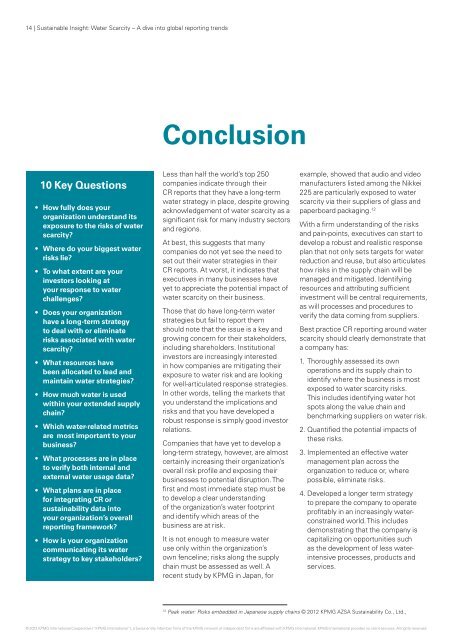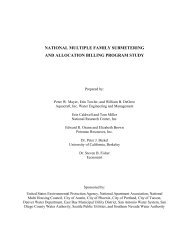Sustainable Insight: Water Scarcity – A dive into global ... - KPMG
Sustainable Insight: Water Scarcity – A dive into global ... - KPMG
Sustainable Insight: Water Scarcity – A dive into global ... - KPMG
- No tags were found...
You also want an ePaper? Increase the reach of your titles
YUMPU automatically turns print PDFs into web optimized ePapers that Google loves.
14 | <strong>Sustainable</strong> <strong>Insight</strong>: <strong>Water</strong> <strong>Scarcity</strong> – A <strong>dive</strong> <strong>into</strong> <strong>global</strong> reporting trendsConclusion10 Key Questions• How fully does yourorganization understand itsexposure to the risks of waterscarcity?• Where do your biggest waterrisks lie?• To what extent are yourinvestors looking atyour response to waterchallenges?• Does your organizationhave a long-term strategyto deal with or eliminaterisks associated with waterscarcity?• What resources havebeen allocated to lead andmaintain water strategies?• How much water is usedwithin your extended supplychain?• Which water-related metricsare most important to yourbusiness?• What processes are in placeto verify both internal andexternal water usage data?• What plans are in placefor integrating CR orsustainability data <strong>into</strong>your organization’s overallreporting framework?• How is your organizationcommunicating its waterstrategy to key stakeholders?Less than half the world’s top 250companies indicate through theirCR reports that they have a long-termwater strategy in place, despite growingacknowledgement of water scarcity as asignificant risk for many industry sectorsand regions.At best, this suggests that manycompanies do not yet see the need toset out their water strategies in theirCR reports. At worst, it indicates thatexecutives in many businesses haveyet to appreciate the potential impact ofwater scarcity on their business.Those that do have long-term waterstrategies but fail to report themshould note that the issue is a key andgrowing concern for their stakeholders,including shareholders. Institutionalinvestors are increasingly interestedin how companies are mitigating theirexposure to water risk and are lookingfor well-articulated response strategies.In other words, telling the markets thatyou understand the implications andrisks and that you have developed arobust response is simply good investorrelations.Companies that have yet to develop along-term strategy, however, are almostcertainly increasing their organization’soverall risk profile and exposing theirbusinesses to potential disruption. Thefirst and most immediate step must beto develop a clear understandingof the organization’s water footprintand identify which areas of thebusiness are at risk.It is not enough to measure wateruse only within the organization’sown fenceline; risks along the supplychain must be assessed as well. Arecent study by <strong>KPMG</strong> in Japan, forexample, showed that audio and videomanufacturers listed among the Nikkei225 are particularly exposed to waterscarcity via their suppliers of glass andpaperboard packaging. 12With a firm understanding of the risksand pain-points, executives can start todevelop a robust and realistic responseplan that not only sets targets for waterreduction and reuse, but also articulateshow risks in the supply chain will bemanaged and mitigated. Identifyingresources and attributing sufficientinvestment will be central requirements,as will processes and procedures toverify the data coming from suppliers.Best practice CR reporting around waterscarcity should clearly demonstrate thata company has:1. Thoroughly assessed its ownoperations and its supply chain toidentify where the business is mostexposed to water scarcity risks.This includes identifying water hotspots along the value chain andbenchmarking suppliers on water risk.2. Quantified the potential impacts ofthese risks.3. Implemented an effective watermanagement plan across theorganization to reduce or, wherepossible, eliminate risks.4. Developed a longer term strategyto prepare the company to operateprofitably in an increasingly waterconstrainedworld. This includesdemonstrating that the company iscapitalizing on opportunities suchas the development of less waterintensiveprocesses, products andservices.12Peak water: Risks embedded in Japanese supply chains © 2012 <strong>KPMG</strong> AZSA Sustainability Co., Ltd.,© 2012 <strong>KPMG</strong> International Cooperative (“<strong>KPMG</strong> International”), a Swiss entity. Member firms of the <strong>KPMG</strong> network of independent firms are affiliated with <strong>KPMG</strong> International. <strong>KPMG</strong> International provides no client services. All rights reserved.
















